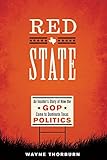Red State : An Insider's Story of How the GOP Came to Dominate Texas Politics / Wayne Thorburn.
Material type: TextSeries: Jack and Doris Smothers Series in Texas History, Life, and CulturePublisher: Austin : University of Texas Press, [2021]Copyright date: ©2014Description: 1 online resource (310 p.)Content type:
TextSeries: Jack and Doris Smothers Series in Texas History, Life, and CulturePublisher: Austin : University of Texas Press, [2021]Copyright date: ©2014Description: 1 online resource (310 p.)Content type: - 9780292759213
- 324.09764/09045 23
- online - DeGruyter
| Item type | Current library | Call number | URL | Status | Notes | Barcode | |
|---|---|---|---|---|---|---|---|
 eBook
eBook
|
Biblioteca "Angelicum" Pont. Univ. S.Tommaso d'Aquino Nuvola online | online - DeGruyter (Browse shelf(Opens below)) | Online access | Not for loan (Accesso limitato) | Accesso per gli utenti autorizzati / Access for authorized users | (dgr)9780292759213 |
Frontmatter -- Contents -- Preface and Acknowledgments -- A Note on Sources -- 1. Understanding Texas -- 2. Dividing the State -- 3. A Century of One-Party Politics -- 4. Stirrings and Small Cracks -- 5. Toward a Two-Party Texas -- 6. The Two-Party Interlude -- 7. The Era of Republican Dominance -- 8. The Future of Texas Politics -- Notes -- Bibliography -- Index
restricted access online access with authorization star
http://purl.org/coar/access_right/c_16ec
In November 1960, the Democratic party dominated Texas. The newly elected vice president, Lyndon Johnson, was a Texan. Democrats held all thirty statewide elective positions. The state legislature had 181 Democrats and no Republicans or anyone else. Then fast forward fifty years to November 2010. Texas has not voted for a Democratic president since 1976. Every statewide elective office is held by Republicans. Representing Texas in Washington is a congressional delegation of twenty-five Republicans and nine Democrats. Republicans control the Texas Senate by a margin of nineteen to twelve and the Texas House of Representatives by 101 to 49. Red State explores why this transformation of Texas politics took place and what these changes imply for the future. As both a political scientist and a Republican party insider, Wayne Thorburn is especially qualified to explain how a solidly one-party Democratic state has become a Republican stronghold. He analyzes a wealth of data to show how changes in the state’s demographics—including an influx of new residents, the shift from rural to urban, and the growth of the Mexican American population—have moved Texas through three stages of party competition, from two-tiered politics, to two-party competition between Democrats and Republicans, and then to the return to one-party dominance, this time by Republicans. His findings reveal that the shift from Democratic to Republican governance has been driven not by any change in Texans’ ideological perspective or public policy orientation—even when Texans were voting Democrat, conservatives outnumbered liberals or moderates—but by the Republican party’s increasing identification with conservatism since 1960.
Mode of access: Internet via World Wide Web.
In English.
Description based on online resource; title from PDF title page (publisher's Web site, viewed 26. Apr 2022)


